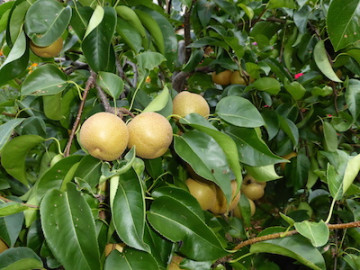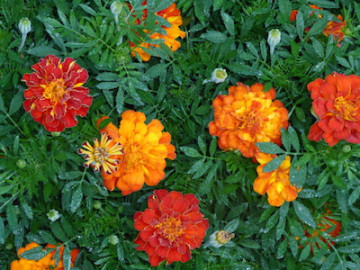Urban Gardener: Peerless Pears
Saturday, August 23, 2014
Space conscious urban gardeners do well to consider the superb pear. This fruit is native to temperate regions of Eurasia and among the first domesticated fruits. They are famously long lived and sailed to America with the Pilgrims. Millennia of selective breeding have produced many cultivars, some with distinct regional characteristics. As humans spread across the world they brought pears with them. Subspecies have gained popularity in recent years; pears share universal soil and light requirements. Varieties are available for early, mid and late season, generally from mid-August through October. Their merits are endless.
A classic expansion of small spaces is to think vertically. Pear trees utilize full sun, are not fussy about soil other than well drained, and are virtually pest free with modest care. The pear is a good introduction to fruit growing. Their delightful taste is matched only by normally abundant crops. Few garden displays are as rewarding as a pear tree full of fruit. Inexpensive to buy or easy to root from cuttings, pears endure.
Like most gardeners, my plant wish list is far larger than my garden plot. Despite rigorous selection and cost benefit analysis, pears remain on the list. Factors to consider in pear selection are hardiness, they grow from zone 3-10, size, such as dwarf or standard, and perhaps the most important, taste. Pears are winners from the very beginning with gentle white flowers in spring. It’s better to plant two pears for optimum cross pollination. Our urban environment has pears planted over generations and many gardeners benefit from neighbor’s pears for pollination. It is possible to restore an old pear into fruit production although many old pears produce bountiful yields without any apparent care. This is a fruit tree for the minimalist.
GET THE LATEST BREAKING NEWS HERE -- SIGN UP FOR GOLOCAL FREE DAILY EBLASTMost gardeners order fruits such as pears as field grown saplings, they are mailed to homes early in spring. Don’t be discouraged by their broomstick appearance. Always prepare a $100 hole for a $10 plant. It is much easier to nurture premium soil in specific places than to upgrade existing grounds. Soak the sapling in water or wrap in wet burlap until you’ve dug a fine hole just a bit larger than the rootstock. Loosen hard packed soil, remove or prune back roots from distant trees and mix into the soil plenty of organic materials. Our soils are often left over from construction projects or reclaimed from building spots. Pears will do well for you with equal measures of preparation and hope. This is a fruit tree that rewards faith.
I dust the modest roots with Rootone, a root promoting hormone, and mix plenty of bone meal and pelletized dolomite limestone to add nutrients leached from soil. Always plant trees with their roots spread outward and untangled. Make a small heap in the bottom of the hole, place the sapling on top with the roots radiating away from the center. Fill in the hole, tamp down the soil. The goal is to plant the tree at the same depth as originally grown, the soil line should be at the juncture of root and stem. Grafted fruit trees are planted with the graft above the soil. Stake the trees for the first season or two to steady in gale winds. Once established, the stakes may be removed.
Pears are vigorous. Saplings arrive pre-pruned. Allow them freedom to grow and settle in. This happens rather quickly. The objective is to grow a pear in the shape of a Christmas tree. Prune out weak or broken branches, any “water sprouts” or shoots that emerge close to the soil and any branches that cross or rub one another. Dwarf fruit trees yield the same sized fruit as standard trees. Plant dwarf trees 10-15 apart. Not an inch is wasted, strawberries thrive around the bases of my pear tree as does turf.
Comb through your pear tree a month or so after bloom when the fruit are about the size of cherries and repeat at intervals during the growing season. Most pears set generous amounts of fruit. Thinning allows the remaining pears to grow larger. Older pear trees should be groomed, remove dead or broken branches, prune out spindly inner branches, take away any self-sown seedlings. A rule of thumb is to remove about a third of the growth for a couple seasons. Fruit sets on 2-3 year old growth. Worst case? Take down the old tree and plant new. You’ll be picking fruit in 2 years.
Harvest pears before fully ripened on the tree. Kept in a cool dark place they will store much like potatoes. Look for a faint yellow blush on the fruit and pick when still green. Of course, it’s fine to eat ripe fruit right off the tree. Throw the windfalls into your compost heap or bury under the mulch. Yellow jackets are fond of very ripe fruit, indeed become drunken on the fermenting fruit. Sober or drunken, avoid stinging bees.
There are countless recipes for pears. Excellent cooked, they are delicious poached in simple syrups. Squirrels love pears too. Trap them for removal but expect to pay a squirrel tax. Pears thrive in most soils however fertilizer in small amounts, such as 10-10-10 out to the drip line or furthest distance beneath the leaves at a rate of half pound per inch of the diameter of the tree two feet above the soil is the conventional wisdom. Mine thrive without special feeding. They do well in a garden plot constantly mulched and often deeply piled with shredded leaves, hay or manure.
Lovely companion plants for pears are marigolds. They bloom all summer. Marigolds really come into their own in late summer up to frost. Pears above and marigolds beneath are a happy marriage of color and taste.
Extend the pear harvest with early, mid season and late season pears. Most pears offer large crops. You’ll be the hit of the workplace as the harvest is best shared.
Grow pears in your urban garden and never look back. This is a carefree fruit tree that will produce delectable harvests for years and years. Put this winner on your garden wish list.
Leonard Moorehead is a life-long gardener. He practices organic-bio/dynamic gardening techniques in a side lot surrounded by city neighborhoods in Providence RI. His adventures in composting, wood chips, manure, seaweed, hay and enormous amounts of leaves are minor distractions to the joy of cultivating the soil with flowers, herbs, vegetables, berries, and dwarf fruit trees.
Related Articles
- Urban Gardener: Lettuce Among Us
- Urban Gardener: Please Plant Peas
- Urban Gardener: Cold Frames Save the Day
- The Urban Gardener: Cheerful Daffodils
- The Urban Gardener: Rise and Shine
- Urban Gardener: Forsythias Advance on Spring
- Leonard Moorehead, The Urban Gardener: Peerless Pears
- Urban Gardener: Container Gardens
- The Urban Gardener: Strawberries and Chives for All
- Urban Gardener: Summer Transplants Take Root
- Urban Gardener: Volunteers, Step Forward
- Urban Gardener: Summer Solstice Celebration
- Urban Gardener: Dearest Peaches
- Urban Gardener: Small Fruits, Big Rewards
- Urban Gardener: Presto, it’s Pesto!
- Urban Gardener: Glory Days
- Urban Gardener: Sweet Summer Gardens
- Urban Gardener: Vacation Harvests
- Urban Gardener: Raspberry Razzle Dazzle
- Leonard Moorehead, The Urban Gardener: Oasis of Peace
- Leonard Moorehead, The Urban Gardener: Spring Poised on the Equinox
- Urban Gardener: March Lions Prowl
- Urban Gardener: Not Pot but Potatoes
- Leonard Moorehead, The Urban Gardener: Seeds in the Snowbed
- Urban Gardener: Paradise Survives Snowstorms!






